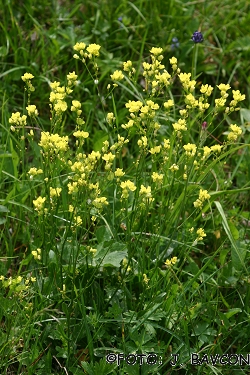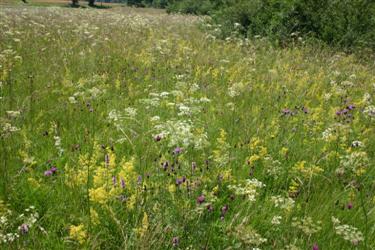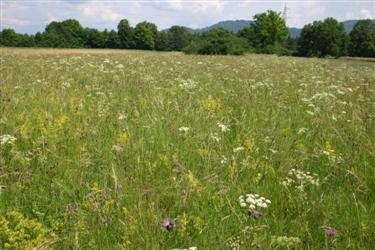The Botanic Garden is not engaged only in the protection of plants in ex- situ but also in situ. Already during World War II Tomažič described dry meadows at Roje near the Sava river. In the course of our field work we often collected plants in that area. In spite of intensive agriculture we nonethelees came upon some areas with an outstanding variety of plants. One of them was also a meadow at Roje. It took us some years to finally take a lease on it. In 2000 its holders told us that it had not been manured for the last forty years. They used to mow it once a year but in the last years not even that. When still mowing it, they noticed flowers such as growing on higher lying mountain meadows.
 The meadow was extremely interesting and colourful. Already the first records revealed the presence of more than 120 plant species (Bavcon & Marinček 2003). The question is of a typical dry meadow on a gravelly soil. On the upper edge of the meadow passing into a strip of shrubs and extending beyond it into fields and higher meadow terraces, common snowdrop (G. nivalis) and spring crocus (C. vernus subsp. vernus) begin to bloom still in winter, rapidly followed by other species. The beginning of May sees the bloom of Globularia punctata, Biscutella laevigata L., some wild orchids: bug orchid (Orchis coriophora L.), military orchid (Orchis militaris L.), green-winged orchid (Orchis morio L.), toothed orchid (Orchis tridentata Scop.), burnt orchid (Orchis ustulata L.), some of which appear in large numbers, and late spider orchid (Ophrys holosericea (Burm.fil.) Greuter). Then comes the blooming time of numerous dyer’s greenweed (Genista tinctoria L.) and sticky flax (Linum viscosum L.). By the end of May and in mid-June they are joined by fire lily (L. bulbiferum) and later by wild gladiolus (Gladiolus illiyricus Koch ex Sturm) which is quite massive in certain spots. Galium verum L. throws a splash of yellow over the meadow.
The meadow was extremely interesting and colourful. Already the first records revealed the presence of more than 120 plant species (Bavcon & Marinček 2003). The question is of a typical dry meadow on a gravelly soil. On the upper edge of the meadow passing into a strip of shrubs and extending beyond it into fields and higher meadow terraces, common snowdrop (G. nivalis) and spring crocus (C. vernus subsp. vernus) begin to bloom still in winter, rapidly followed by other species. The beginning of May sees the bloom of Globularia punctata, Biscutella laevigata L., some wild orchids: bug orchid (Orchis coriophora L.), military orchid (Orchis militaris L.), green-winged orchid (Orchis morio L.), toothed orchid (Orchis tridentata Scop.), burnt orchid (Orchis ustulata L.), some of which appear in large numbers, and late spider orchid (Ophrys holosericea (Burm.fil.) Greuter). Then comes the blooming time of numerous dyer’s greenweed (Genista tinctoria L.) and sticky flax (Linum viscosum L.). By the end of May and in mid-June they are joined by fire lily (L. bulbiferum) and later by wild gladiolus (Gladiolus illiyricus Koch ex Sturm) which is quite massive in certain spots. Galium verum L. throws a splash of yellow over the meadow. 







